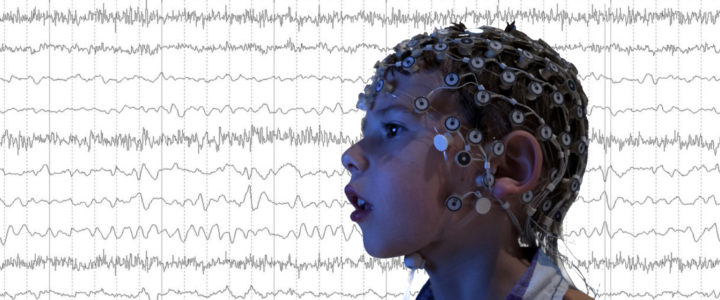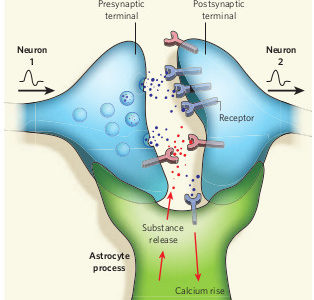With a $90,000 grant from FRAXA Research Foundation awarded over 2016-2017, University of California researchers Khaleel Razak, PhD, and Jonathan W. Lovelace, PhD, are exploring drug combinations to limit hypersensitivity to sounds in Fragile X mice.
Read moresound
Why study auditory systems in Fragile X syndrome? The brain’s system for processing sounds is much better known and easier to study than learning and memory processing. Researchers are finding that interventions and treatments which normalize auditory systems (in Fragile X animal models) also correct cognition.
.
Neural Markers of Fragile X: A Powerful New Tool for Clinical Trials

Once the neural marker is identified for a particular challenge, such as kids with poor language versus good language, neural markers can be measured during drug and behavioral therapy trials to see if a child is improving based on objective biological measures.
Read morePreclinical Testing of Sleep-Wake Patterns as an Outcome Measure for Fragile X

FRAXA Research Foundation awarded $122,000 over 2016-2018 to Dr. Cara Westmark at the University of Wisconsin at Madison for studies of sleep disorders in Fragile X syndrome.
Read moreKimberly Huber, PhD, Explores Hyperexcitability in Fragile X Syndrome

Ever wonder why your child with Fragile X suddenly screams for no apparent reason or jumps and flaps uncontrollably seemingly for hours? You got it: hyperexcitability. But what exactly causes it? And what can fix it? Kimberly Huber, PhD, is working long and hard in her lab to answer those questions. Dr. Huber, professor, Neuroscience, UT Southwestern Medical Center, is seeking to understand how FMRP regulates connections between brain cells, called synapses, and the function of brain circuits, which are several connected brain cells.
Read moreUniversity of Michigan researcher Peter Todd, MD, PhD, Aims to Selectively Turn the Fragile X Gene Back on in Human Cells

Fish like salmon are born in fresh water streams and rivers. When the time comes for them to breed, they return to the stream of their birth to lay eggs in the same spot where they were born. To accomplish this, they must swim upstream against the current or flow of the stream. Taking a page out of the salmon DNA playbook, University of Michigan scientists Peter Todd, MD, PhD, and postdoctoral fellow Jill Haenfler, Ph.D., are exploring unchartered waters to find a cure for Fragile X Syndrome. The researchers are adapting CRISPR research to reactivate the FMR1 gene, which provides instructions for making a protein called FMRP — needed for normal brain development.
Read moreMeltdown no more? Targeting Hypersensitivity in Fragile X

We’ve all been there. Our child with Fragile X hears something and becomes excited. Very excited. Hand flapping follows with non-stop jumping and ear-piercing squawking. Nothing helps. No meds. No iPhone. No magic toy. Several minutes go by. Sometimes longer. How many times have you apologized in a grocery store — or restaurant — or at the mall? Wouldn’t it make our lives better if this unpredictable excitability was minimalized or eliminated? That’s the premise behind research being conducted at University of California, Riverside. Principal Investigator Khaleel Razak, PhD, and postdoctoral fellow Jonathan W. Lovelace, PhD, are studying mice genetically altered to mimic the genetic characteristics of humans with Fragile X Syndrome.
Read moreFragile X Treatment: New Research Directions

In the wake of negative results from several high-profile clinical trials in Fragile X, we find ourselves questioning many of our previous assumptions about the nature of this disorder. After all, understanding the basic pathology of disease is critical to development of new treatments — this is true across the board, in all branches of medicine.
Read moreNIH Awards $35 Million to Three Fragile X Research Teams

The National Institutes of Health has just announced new awards of $35 million over five years to support three Centers for Collaborative Research in Fragile X. Investigators at these centers will seek to better understand Fragile X-associated disorders and work toward developing effective treatments. All of these scientists have been funded for years by FRAXA Research Foundation, and now each team will receive over $2 million per year for five years!
Read morePotassium Channel Modulators to Treat Fragile X

With $246,000 in funding from FRAXA over 2012-2014, the Yale University team of Leonard Kaczmarek, PhD, showed that loss of FMRP leads to an increased Kv3.1 potassium currents and decreased Slack potassium currents in neurons. Both of these changes impair timing of action potentials in auditory neurons (and likely others throughout the brain). The team also found that the firing pattern of neurons in response to repeated stimulation is severely abnormal in Fragile X mice. Based on these results, they are collaborating with the UK-based company Autifony to develop and test advanced compounds which may reverse these deficits.
Read moreEffects of minocycline on vocal production and auditory processing in a mouse model of Fragile X

With $135,000 in grants from FRAXA Research Foundation over several years, Dr. Khaleel Razak and Dr. Iryna Ethell explored robust biomarkers relevant to the FXS and the efficacy of minocycline treatment.
Read moreCompound that Inhibits mGluR5 Corrects Signs of Fragile X in Adult Mice
A study finds that a new compound reverses many of the major symptoms associated with Fragile X syndrome (FXS). The paper is published in the April 12 issue of the journal Neuron, describing the exciting observation that the FXS correction can occur in adult mice, after the symptoms of the condition have already been established. Previous research has suggested that inhibition of mGlu5, a subtype of receptor for the excitatory neurotransmitter glutamate, may ameliorate many of the major symptoms of the disease. This study, a collaboration between a group at Roche in Switzerland, led by Dr. Lothar Lindemann, and Dr. Mark Bear’s MIT lab, used an mGlu5 inhibitor called CTEP to examine whether inhibition of mGlu5 could reverse FXS symptoms.
Read moreGABAergic Inhibitory Function in Fragile X Syndrome

With a $100,000 grant from FRAXA Research Foundation, Drs. Joshua Corbin and Molly Huntsman from the Children’s National Medical Center examined the role of a particular class of brain cells (inhibitory interneurons) that dampen excessive activity in the “emotional center of the brain” (the amydala). This inhibition is deficient in Fragile X, and so they are looking for ways to remedy this. This is particularly interesting to parents of children who are overly anxious and emotional. They worked with Dr. Walter Kaufmann, a clinician at Kennedy Krieger Institute in Maryland.
Read moreThe Slack Potassium Ion channel is a Therapeutic Target for Fragile X

With $282,000 in funding from FRAXA Research Foundation, Dr. Leonard Kaczmarek and colleagues explored association of Slack channels with the Fragile X protein (FMRP).
Read moreGenome-wide Epigenetic Markers in Fragile X

With $45,000 in grants from FRAXA Research Foundation over several years, Dr. Miklos Toth of Cornell University studied epigenetics (ie factors other than the gene itself) which can determine symptom severity in Fragile X.
Read moreElectrophysiological, Biochemical and Immunohistochemical Characterization of Kv3.1 in Auditory Brainstem Nuclei in the Fragile X Knockout Mouse

With $80,000 in funding from FRAXA over several years, the Yale University team of Leonard Kaczmarek, PhD showed that loss of FMRP leads to an increased Kv3.1 potassium currents. This change impairs timing of action potentials in auditory neurons (and likely others throughout the brain).
Read moreBaclofen: GABA(B) Receptor Supersensitivity and Normalization of Behavioral Abnormalities by Various GABA(B) Agonists Including Baclofen in FMRP Deficient Mice

With $110,000 in grants from FRAXA Research Foundation over several years, Dr. Miklos Toth from Cornell University discovered increased startle response in Fragile X mice and that baclofen can correct this phenotype.
Read moreGenetic and Behavioral Analyses of the dFMR1 Pathway in Drosophila Peripheral Nervous System

With a $160,000 grant from FRAXA Research Foundation from 2004-2006, Dr. Fen-Biao Gao and his team at the University of California studied the relationship between mRNA and FMRP.
Read moreMolecular Basis of Increased Seizure Severity in the Fragile X Knockout Mouse
With a $50,000 grant from FRAXA Research Foundation from 2002-2003, Dr. Carl Dobkin and his team at the New York Institute for Basic Research studied the causes for heightened seizure activity in Fragile X mice. Results published.
Read moreTreatment of a Mouse Model of Fragile X Syndrome with MPEP

With a $49,000 grant from FRAXA Research Foundation in 2003, Dr. Linda Crnic at the University of Colorado continued studies of MPEP in Fragile X mice, exploring whether chronic use improves symptoms of Fragile X syndrome without impairing cognitive function.
Read moreMelatonin Clinical Trial in Fragile X

With a $60,000 grant from FRAXA Research Foundation from 1998-1999, Dr. Randi Hagerman and her team at the University of California studied the effects of different compounds on individuals with Fragile X syndrome, focusing specifically on melatonin. Results published.
Read more
